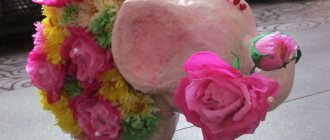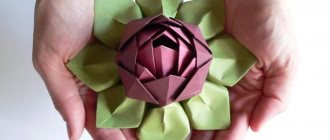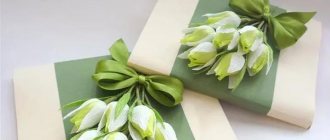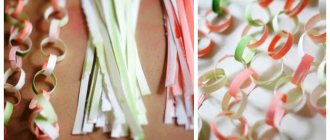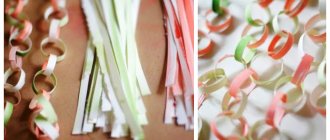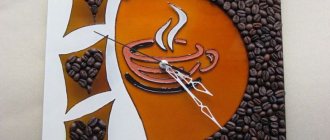Kusudama technique for beginners: making a bell out of paper
We learn to fold unusual buds and collect them into a spherical bouquet using Japanese technology. More details >
What to give for Teacher's Day: 10 master classes + BONUS > 12 master classes on how to knit your first scarf, bactus or snood for beginners > Crochet: 12 bright master classes for your inspiration > How to sew a bag with your own hands: 15 master classes classes for every taste >
Subscribe to the Masters Fair on social networks: Yandex.Zen, Instagram, Facebook, VKontakte
What materials can you use to make an unusual bouquet?
Original bouquets not made from flowers can be made from almost any material. Also, a lot depends on the design and tools for wrapping.
Today, in addition to plastic film or craft paper, they use:
- burlap;
- hard fabrics;
- carton boxes;
- knitted details;
- souvenirs;
- shells;
- buttons.
To create bouquets, you can use different materials and decor.
To create a harmonious composition, an important role is played by the color and pattern available on the future packaging, for example:
- white color will give the bouquet special tenderness;
- red - will create an atmosphere of passion;
- yellow – will give joy and warmth.
In addition to products, various accessories, equipment, jewelry, and decorative elements are used in bouquets.
For men this is most often:
- beautiful belts;
- various gadgets;
- alcohol;
- items of clothing.
For women, experts advise choosing:
- small soft toys;
- banknotes;
- silk and satin ribbons;
- beads or beads;
- fruits and berries;
- candies and chocolate.
Bouquets made from socks as gifts for men look original.
Bouquets made from socks and ties look unusual and ambiguous: both can be folded in the form of flower buds. Food options containing sausage, cheese, and fish are appreciated. Such contents can be placed on the table if desired.
Crafts for kindergarten
A lot of available materials are used to create DIY flowers for kindergarten.
Flowers should decorate not only the interior of kindergarten groups. Children go for walks in the kindergarten every day, twice a day. And there, too, they should see the beauty and well-groomed nature of the trees, shrubs, and flower beds.
To keep your child busy at home with something useful and, at the same time, make a craft to decorate the kindergarten area, you can make flowers from plastic bottles.
The bottoms of the bottles are almost ready-made flowers. Use your imagination. Help your child cut out one flower, attach it to a long skewer or wire, this is a great option for decorating flower beds in early spring, when the flowering time has not come, but you really want beauty.
More options
Of course, it is customary to give bouquets to ladies. But what about our male population? There are many sections on the Internet for this. There, experienced craftswomen tell in detail about how to make a men's bouquet with their own hands.
The manufacturing principles are absolutely the same as described above. You can simply choose a color palette in more “masculine” tones. For example, chocolate-nut or chocolate-beige.
- Vitamins for treating depression
- How to properly post crowdlinks
- Making a beautiful pendant with your own hands
Ideas for themed bouquets
For holidays and memorable dates, you can come up with various options for unusual bouquets that match the theme of the event.
Bouquets of marshmallows and marmalade in the shape of hearts are a great gift for February 14th
For example, for February 14, which is considered Valentine’s Day, the following options for thematic compositions are relevant:
- a heart made from soft toys for a girl and from models of cars or lighters for a guy;
- bouquet of different sweets;
- box with fruits and flowers with built-in power supply.
The last option can remind you of a memorable date for a long time: by the time the flowers fade, all the candies will be eaten.
Original non-flower bouquets for March 8 may be as follows:
- cute small soft toys:
- decorative butterflies or beads;
- jewelry or costume jewelry;
- all kinds of cosmetics or care products. Here it is important to know the tastes of the recipient;
- bouquet of sweets and fruits.
All these options are good if you show your imagination and make a bouquet with love. Then the gift will be appreciated.
Choosing a gift for February 23 can also be simple if you know what your beloved defender is interested in and loves.
A meat bouquet is an excellent gift for a man on February 23
This could be the following composition:
- meat. The ingredients used are those types of sausages that the man prefers. This luxury is decorated with herbs, hot peppers or small bottles of seasonings. Snacks and delicious bread will also be good;
- sea Shrimp, dried and dried squid, a bottle of good beer will melt the heart of the sternest man;
- fruity. This option is not for everyone, because not all men like fruit. You need to choose what he really likes, and for dessert add a bottle of good wine or champagne.
You can also prepare gifts for the New Year. Not only adults, but also children will be happy with them.
For example, for:
- For little fidgets, you can prepare not a package of sweets, but a bouquet of sweets, inside of which the toy that he has long dreamed of should be hidden;
- The young artist can prepare a bouquet of a composition made from paints, pencils and an album;
- You can give a girl a bouquet of bears or dogs, inside of which a doll sits with a regal look or a beautiful hair clip is inserted.
A bouquet of banknotes can be given for various celebrations, for example, for a wedding.
Teenagers will be delighted to have a gadget or a ticket to their favorite band, which are hidden inside a sweet scattering of candies, berries or fruits. For a man, you can make a bouquet of clothes by folding a beautiful tie or T-shirt in an exotic color. You can use a bow tie, tie or scarf as decoration.
A bouquet for a common table may include:
- cones;
- spruce branches;
- New Year's toys;
- candles.
Unusual bouquets created with your own hands will please anyone. You can use food, jewelry and banknotes as an original composition.
For children, a bouquet of candies and other sweets will be a welcome gift, a beloved man will be happy with a set of beer and dried fish, and a daughter will appreciate a small bouquet in which a fashionable gadget occupies the main place. The main thing is to give gifts with love, which is much more valuable than a huge bouquet of ordinary flowers.
Good mood for creativity
Good taste, imagination and imagination simply encourage you to engage in this type of creativity. This exciting activity will require accuracy, patience and perseverance.
To work you will need fabric, scissors, a needle and thread, a glue gun, brushes and paints, and most importantly, a good mood! This exciting type of needlework will seem not like work, but like relaxation, which will relieve stress and help you forget about your current problems at least for a while.
To make flowers from fabric, you will need copper, steel or aluminum wire for the stems, fishing line or nylon thread to create decorated fragments from beads and beads, cotton wool to create unopened buds, as well as semolina or crushed coal to imitate stamens and pollen.
Tools for making artificial flowers
In order for artificial flowers to be as similar as possible to real ones, to give the work grace and subtlety, you will need a fairly decent set of tools:
- Tweezers or tweezers for forming or corrugating petals;
- metal balls with a wooden handle (bulki) for squeezing out petals;
- large and small sharp scissors;
- awl;
- thin and thick wire;
- knife for creating veins;
- mortar for squeezing out petals when making rose flowers;
- tissue paper or thin silk, cotton wool - to create the stem and other parts of the flower;
- rubber plate for squeezing out small depressions;
- metal platform for knocking out the desired shape;
- molds for cutting blanks;
- fabric: silk, satin, cambric, satin, velvet, plush, taffeta, muslin
- dyes for fabric and brushes of different sizes;
- stand for drying flowers;
- glue for joining flower parts and making stamens.
As a good adhesive composition, which also serves for the production of small buds, flower cores and other small elements, a dough-like mixture is recommended, which is made from 60-70 g of gum arabic, made from acacia resin and the same amount of starch. Gum arabic is diluted with a third of a glass of warm water and left until completely dissolved, after which starch is added to the vessel and stirred thoroughly, avoiding the appearance of lumps. The longer such glue lasts, the better its quality. If the surface of the glue dries out slightly, you can “refresh” it by pouring hot water over it and immediately draining it. To glue the glue petals, take a very small amount of glue, applying a drop to the very tip of the part. If necessary, the glue can be tinted to the desired color. It is very important that cherry resin is not used as gum arabic.
- According to the manual, only acacia tree resin is suitable for making artificial flowers.
Basic techniques for making artificial flowers with your own hands
When they start making a flower, the first thing they do is take a wire, wrap it with cotton wool, bend the upper end of the wire into a hook, and then tightly wrap the workpiece with tissue paper or thin silk, which originate inside the loop.
Having secured the strip on the top hook, the wire is quickly rotated with the index and thumb of the left hand, due to which the paper (silk) lies evenly and very tightly. By wrapping leaves or buds around the stem, the excess strips are cut off. They do the same thing when wrapping a stem with cotton wool: the material is straightened, giving it the appearance of a long thread and wound around the stem, cutting off the excess. In specialized literature there may be a professional name for such a stem - liton (or leton in ancient literature). You should remember this rule: if the stem should be thin, then use very little cotton wool - just to cover the wire; if you need to get a thick flexible stem, then you need to take more cotton wool. if you need to make a spherical core or bud, then the cotton wool is tightly wound around the upper end of the wire, bent with a hook, and with your fingers you give the material the required shape. To make the stems of very small flowers - for example, lilac or mignonette, cotton wool is not used at all: the wire is immediately wrapped around paper or silk.
Coloring artificial flowers
Flowers made from cambric or any other paper fabric first need to be moistened. The cut petals are folded 6 or 8 times, after which they are dipped in a saucer of water, squeezed out (without crushing) by hand and laid out to dry on paper that absorbs water well - a filter, blotter, paper towel, etc. A small amount of the desired paint is dripped onto the slightly damp petal, which is then leveled with a finger or a thin brush. If the color needs to be reduced to completely transparent, then a small drop of water is added to this place, which blurs the paint. After these manipulations, stripes, specks and other elements are painted with a brush, bringing the color of the flower closer to natural. After all the blanks have dried, you can start corrugating, pleating or squeezing them with hot/cold bullets - depending on the type of flower. Corrugation
artificial flowers are made either using tweezers or a spherical tool (bulka). An approximate operating algorithm would be as follows:
- the petal is folded in half along the long side;
- put it on the palm of the left hand, and with the right hand, using tweezers, scratch grooves on it from top to bottom;
- after the workpiece is unfolded, identical grooves will be found on it, symmetrically located relative to the center of the petal;
- the same is done for the lower part of the petal or by directing the grooves radially to the sides from the center.
If the petal needs to be given a curved or concave shape, then it is convenient to use a tool with a ball-shaped nozzle: small pieces are placed on a rubber plate, larger ones - on a dense, tight pillow (you can fill it with fine river sand) and take a boule with the required ball size in your right hand . The tool is used with light rotational movements, sliding the ball from the edges to the center of the petal, gradually giving it a rounded shape.
